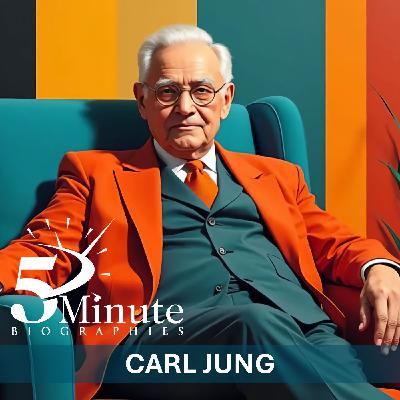Carl Jung
Description
Carl Gustav Jung was born on 26 July 1875 in Kesswil, Switzerland. He became one of the most influential figures in psychology, renowned for his work in analytical psychology and his development of concepts such as the collective unconscious, archetypes, and psychological individuation. His contributions shaped modern psychology and influenced various fields, including philosophy, anthropology, and religious studies.
Jung was born into a Protestant family, with his father serving as a pastor. His early life was marked by introspection and a fascination with dreams, spirituality, and the nature of human consciousness. He pursued his studies at the University of Basel, where he initially considered specialising in archaeology before shifting to medicine. He later attended the University of Zurich, where he focused on psychiatry, working under Eugen Bleuler, a prominent psychiatrist known for his research on schizophrenia. Jung’s early exposure to psychiatric work laid the foundation for his later theories on the human psyche.
In 1903, Jung married Emma Rauschenbach, who became a significant partner in both his personal and professional life. Their marriage provided stability, and Emma played a key role in supporting his intellectual pursuits. Jung’s early career saw him working at the Burghölzli Psychiatric Hospital in Zurich, where he conducted experiments in word association and developed ideas on the unconscious mind. His work at Burghölzli brought him into contact with Sigmund Freud, the founder of psychoanalysis.
Jung and Freud initially shared a strong professional bond, with Jung being seen as Freud’s intellectual heir. Their correspondence and collaboration were extensive, and Jung contributed significantly to the psychoanalytic movement. However, fundamental theoretical differences emerged between them. Freud emphasised the role of sexual drives in shaping human behaviour, whereas Jung believed in a broader understanding of the unconscious, incorporating mythology, symbolism, and spirituality. Their divergence led to a formal break in 1913, with Jung developing his own school of analytical psychology.
The period following his split from Freud was one of intense self-exploration for Jung. He withdrew from professional engagements and embarked on a deep psychological journey, which he documented in “The Red Book.” This work, which was only published posthumously, detailed his inner experiences, visions, and dialogues with archetypal figures. It was during this time that he formulated some of his most enduring ideas, including the concepts of the collective unconscious and archetypes.
Jung proposed that, beyond personal unconscious experiences, all humans share a collective unconscious made up of inherited symbols and patterns, known as archetypes. These archetypes, including figures such as the Hero, the Shadow, and the Anima and Animus, manifest in myths, dreams, and cultural narratives across societies. His exploration of these universal symbols greatly influenced the fields of comparative mythology and religious studies, as well as depth psychology.
Jung introduced the process of individuation as a central goal of psychological development. He argued that individuals must integrate various aspects of their unconscious into their conscious self to achieve wholeness and fulfil their potential. This concept contrasted with Freud’s focus on resolving internal conflicts stemming from early childhood experiences. Jung’s approach aimed at helping individuals realise their unique paths through personal growth and self-discovery.
His work extended into personality theory, where he introduced the concepts of introversion and extraversion, now widely used in personality psychology. He also developed the idea of psychological types, which later became the foundation for the Myers-Briggs Type Indicator (MBTI), a popular personality assessment tool. His insights into personality continue to be relevant in both clinical psychology and popular culture.
Jung’s interest in spirituality and religious traditions set him apart from many of his contemporaries. He studied alchemy, Gnosticism, Eastern philosophies, and Western mysticism, incorporating their symbolic meanings into his psychological framework. He believed that modern individuals suffered from a loss of spiritual connection and that psychological healing required a reintegration of symbolic and mythological wisdom.
During the latter part of his career, Jung travelled extensively, engaging with different cultures and studying their psychological traditions. He visited Africa, India, and the United States, where he examined indigenous practices and beliefs, seeking to understand the universality of psychological and spiritual experiences. His global perspective reinforced his belief in the collective unconscious and its manifestations in diverse cultural contexts.
Jung’s influence extended beyond psychology into literature, philosophy, and the arts. Writers such as Hermann Hesse and James Joyce drew inspiration from his ideas, and his concepts of archetypes and individuation have been widely used in narrative storytelling, film, and mythology studies. His work continues to resonate in the modern era, influencing psychotherapy, dream analysis, and the study of symbolic meaning.
In his later years, Jung wrote extensively, producing works such as “Psychological Types,” “Modern Man in Search of a Soul,” and “Memories, Dreams, Reflections.” These writings provided deep insights into his theories and personal experiences, offering a unique perspective on the development of human consciousness and the search for meaning.
On 6 June 1961, Carl Jung passed away in Küsnacht, Switzerland, at the age of 85. He left behind a legacy that profoundly shaped modern psychology and continues to inspire thinkers across disciplines. His contributions to analytical psychology, personality theory, and the study of myths and symbols have had a lasting impact on how humans understand themselves and the world around them. His exploration of the unconscious mind remains a cornerstone of psychological thought, and his belief in the transformative power of self-awareness continues to guide those seeking personal and collective growth. Jung’s legacy is evident in the enduring relevance of his theories, which have transcended the field of psychology to influence philosophy, anthropology, and religious studies. His emphasis on the integration of the unconscious, the significance of mythological patterns, and the process of individuation remains vital to understanding human development. His work has inspired generations of scholars, therapists, and creatives who continue to explore the depths of the human psyche. Carl Jung’s contributions have ensured that his influence endures, making him one of the most profound and far-reaching thinkers of the modern era.
The post Carl Jung appeared first on 5 Minute Biographies.
























